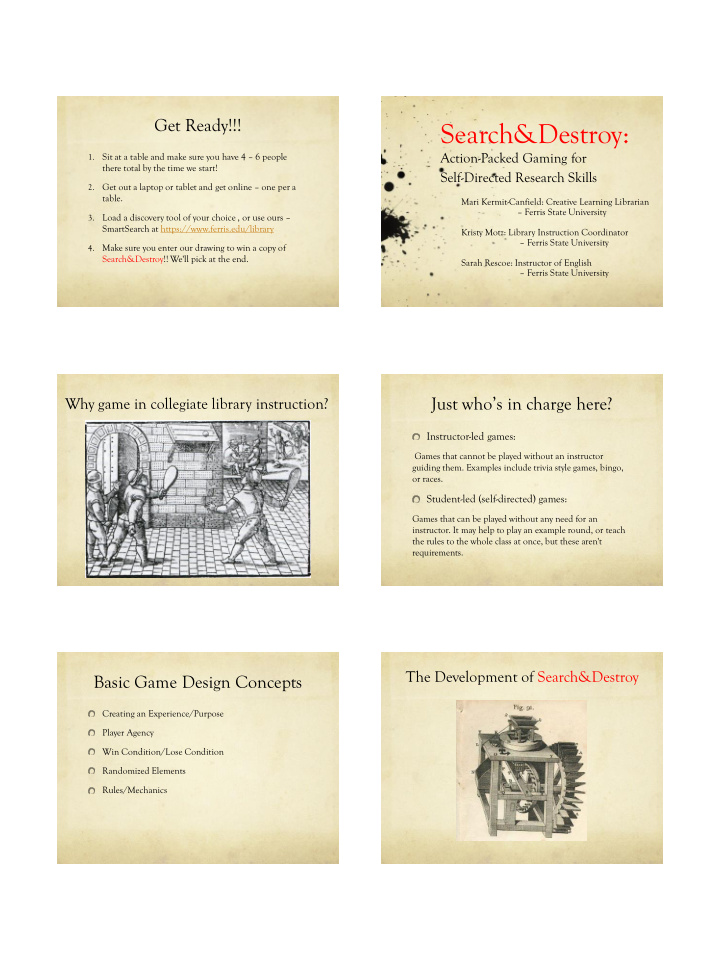



Get Ready!!! Search&Destroy: Action-Packed Gaming for Sit at a table and make sure you have 4 – 6 people 1. there total by the time we start! Self-Directed Research Skills 2. Get out a laptop or tablet and get online – one per a table. Mari Kermit-Canfield: Creative Learning Librarian – Ferris State University 3. Load a discovery tool of your choice , or use ours – SmartSearch at https://www.ferris.edu/library Kristy Motz: Library Instruction Coordinator – Ferris State University Make sure you enter our drawing to win a copy of 4. Search&Destroy!! We'll pick at the end. Sarah Rescoe: Instructor of English – Ferris State University Why game in collegiate library instruction? Just who’s in charge here? Instructor-led games: Games that cannot be played without an instructor guiding them. Examples include trivia style games, bingo, or races. Student-led (self-directed) games: Games that can be played without any need for an instructor. It may help to play an example round, or teach the rules to the whole class at once, but these aren't requirements. The Development of Search&Destroy Basic Game Design Concepts Creating an Experience/Purpose Player Agency Win Condition/Lose Condition Randomized Elements Rules/Mechanics
Learning Outcomes Design Goals for Search&Destroy Database Use Quick to learn Faceting Fast player turns, with meaningful choice Boolean Searching "Dead time," kept to a minimum Search String Development "Screw your neighbor," style interactions Materials Identification and Selection Searching in the database as much as possible Introduction to Peer-Review Concepts Educational elements intimately tied to mechanics Game Mechanics of Search&Destroy The Look & Feel of Search&Destroy A Game Self-publishing Process
Searching for then Destroying 90+ copies, 50+ locations, 4 continents Classic Classroom Instruction Close connection between teaching faculty and librarian with assignment development & research needs 5 years collaboration and information literacy assessment data (Fall 2012 – present) Multi-class visits to target point-of-need instruction: resource evaluation, database searching, citations, and in-depth project work Use of online tutorial with pre- and post- testing scores PILOT Classroom Application – Fall 2017 Search & Destroy applied in 3 English 150 courses One dual enrolled, “high - risk” section (n = 17) One developmental section (n = 22) One standard, prerequisite-met section (n = 23) Students’ Learning Profile Classroom Application - Procedure Dual Enrolled Developmental Standard Writing to persuade and information literacy course unit Multi-class visits to target point-of-need instruction Background 73.34% believed that 26.67% believed that 31.58% believed that their background DID their background DID their background DID Session 1: Information literacy instruction NOT prepare them NOT prepare them NOT prepare them well for this course's well for this course's well for this course's Session 2: Search & Destroy game requirements. requirements. requirements. Learning outcomes Confidence 46.67% believed that 53.34% believed that 57.9% believed that Identify types of sources & source credibility (when this course (when this course (when this course began) they could began) they could began) they could Select resources for academic writing master its content. master its content. master its content. Use library databases Motivation 40% said they put 60% said they put forth 47.37% said they put Instructor observation, assessment, and student forth more effort than more effort than other forth more effort than surveys used to explore value of Search & Destroy other students on students on academic other students on academic work. work. academic work.
Student Evaluation Instructor Assessment Search & Destroy helped me understand the concepts Improved tactical knowledge of of SmartSearch and keywords discussed in class research/SmartSearch/databases Strongly agree Agree Neither Agree or disagree 0 Improved application of knowledge 26.67 26.32 Grade increases on annotated bibliography & papers 46.67 Essays had more correctness and accuracy in use of sources 21.05 26.67 Significant differences between scores on assignments and quizzes in the game learning/online tutorial learning groups vs traditional conditions 53.33 47.37 46.67 Improved ability to navigate their assignments with confidence and in overall research experience Dual Enrolled Developmental Standard Did you enjoy playing Student Evaluation Search&Destroy? (n=49) Search & Destroy added interesting discussion and enhancement to the regular class meetings. Dual Enrolled Developmental Standard No 10% Strongly Agree 33% 27% 37% Agree 47% 40% 42% Neither Agree/Disagree 20% 33% 21% The Search & Destroy game components were clear and organized. Dual Enrolled Developmental Standard Yes Strongly Agree 33.3% 27% 32% 90% Agree 53.3% 40% 32% Neither Agree/Disagree 13.3% 33% 32%
Student Reactions “I honestly would play this game [in] my free time, it was a lot of fun.” “It was really fun and helped me learn how to use SmartSearch Let’s play! better.” “Fun learning game.” “I love this game!” “I thought it was a fun way to learn how to use Smart Search.” “I truly loved this game. I want to purchase it for my family. I wish it were sold in stores! I truly learned a lot about research online. There is much more out there than I had previously known.” “Very helpful.” Post-Play Class Discussion Follow-up discussion points to have with a class: Boolean Operators Faceting Longer and more complex search strings vs. Shorter. Materials selection Student self-evaluations of what they learned from play. Ordering Info ? http://bit.ly/2pCmwoe OR https://www.thegamecrafter.com/games/search-destroy
Recommend
More recommend